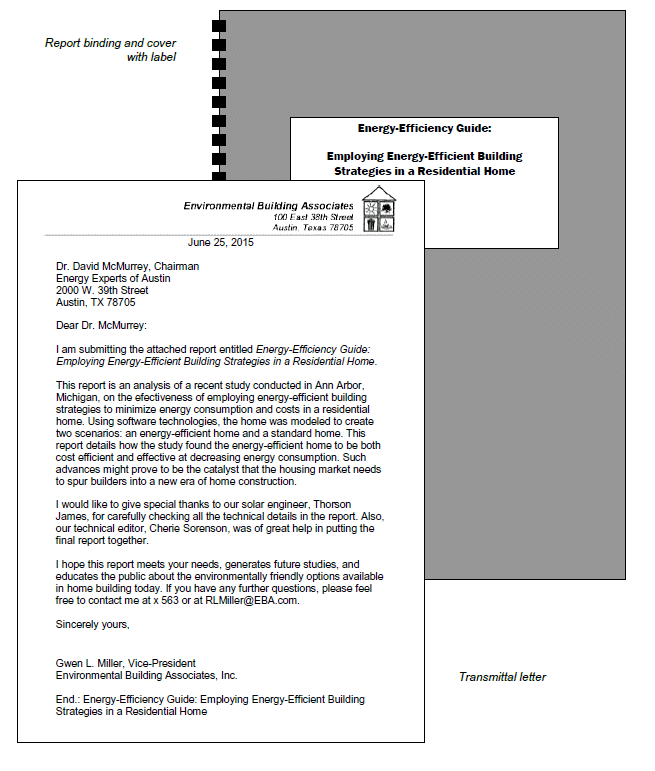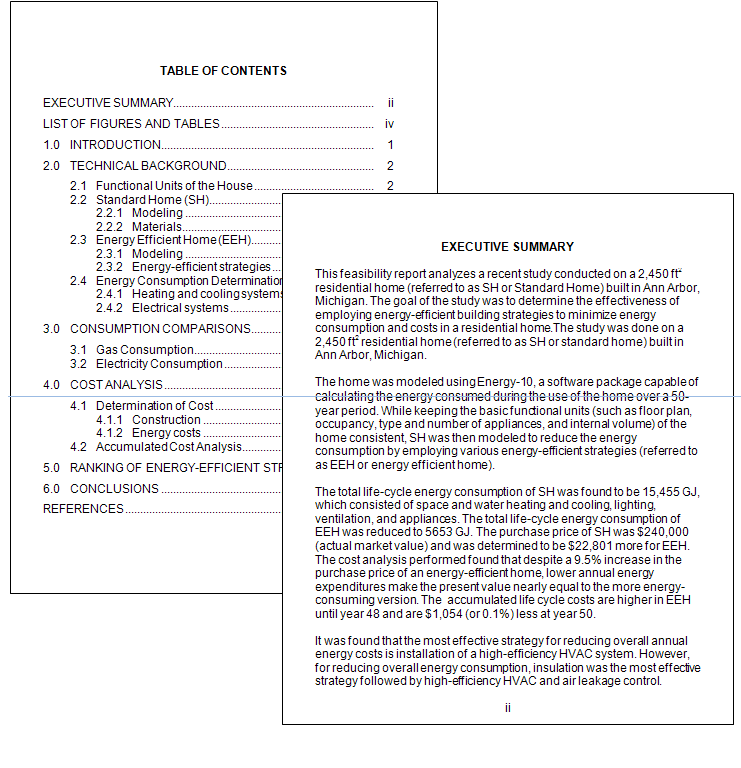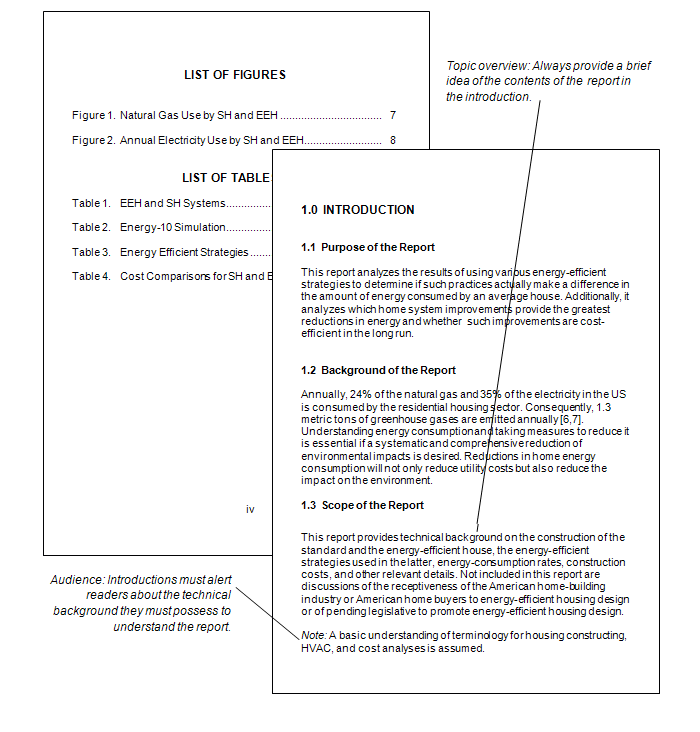11.2 Writing a Formal Report
Report Organization
Reports vary by size, format, and function. You need to be flexible and adjust your report to the needs of the audience. Reports are typically organized around six key elements:
- Who the report is about and/or prepared for
- What was done, what problems were addressed, and the results, including conclusions and/or recommendations
- Where the subject studied occurred
- When the subject studied occurred
- Why the report was written (function), including under what authority, for what reason, or by whose request
- How the subject operated, functioned, or was used
Pay attention to these essential elements when you consider your stakeholders. That may include the person(s) the report is about, whom it is for, and the larger audience of the organization. Ask yourself who the key decision-makers are, who the experts will be, and how your words and images may be interpreted.
While there is no universal format for a report, there is a common order to the information. Each element supports the main purpose or function, playing an important role in the transmission of information. There are several different organizational patterns that may be used for formal reports, but all formal reports contain front matter (prefatory) material, a body, and back matter (supplementary) items. The prefatory material is therefore critical to providing the audience with an overview and roadmap of the report. The body of a formal report discusses the findings that lead to the recommendations. The back matter provides additional information. Some common elements in a report are shown in Activity 11.1 below.
Activity 11.1 | Report Cover and Letter of Transmittal Binding Cover and Letter of Transmittal
Front Matter
Front matter includes all the information preceding the body of the report.
Title Page
The title page provides the audience with the:
- Name of the report
- This should appear 2 inches from the top margin in uppercase letters.
- Name, title, and organization of the individual receiving the report
- Type “Prepared for” on one line, followed by two separate lines that provide the receiving organization’s name. Some reports may include an additional line that presents the name of a specific person.
- Name of the author and any necessary identifying information
- Type “prepared by” on one line, followed by the name(s) of the author(s) and their organization, all on separate lines.
- Date of submission
- This date may differ from the date the report was written. It should appear 2 inches above the bottom margin.
The items on the title page should be equally spaced apart from each other.
A note on page numbers: The title page should not include a page number, but this page is counted as page “i.” Use software features to create two sections for your report. You can then utilize two different types of numbering schemes. When numbering the pages (i.e., i, ii, iii, etc.) for a formal report, use lowercase Roman numerals for all front matter components. Utilize Arabic numbers for the other pages that follow. Additionally, if you intend to bind the report on the left, move the left margin and center 0.25 inches to the right.
A note on font: If there is no specific preference for serif vs. sans serif font, choose one and use it consistently throughout the report. Do not utilize anything besides a traditional serif (e.g., Times New Roman) or sans serif (e.g., Arial or Calibri) font.
Letter or Memo of Transmittal
A letter or memo of transmittal announces the report topic to the recipient(s).
If applicable, the first paragraph should identify who authorized the report and why the report is significant. Provide the purpose of the report in the first paragraph as well. The next paragraph should briefly identify, categorize, and describe the primary and secondary research of the report. Use the concluding paragraph to offer to discuss the report; it is also customary to conclude by thanking the reader for their time and consideration.
A letter of transmittal should be formatted as a business letter. Some report writers prefer to send a memo of transmittal instead. When considering your audience for the letter or memo of transmittal, make sure that you use a level of formality appropriate for your relationship with the reader. While all letters should contain professional and respectful language, you should pay closer attention to the formality of the word choice and tone in a letter to someone you do not know. Figure 11.1 illustrates a report with a letter of transmittal.

Table of Contents
The table of contents page features the headings and secondary headings of the report and their page numbers, enabling audience members to quickly locate specific parts of the report. Leaders (i.e. spaced or unspaced dots) are used to guide the reader’s eye from the headings to their page numbers.
The words “TABLE OF CONTENTS” should appear at the top of the page in all uppercase and bolded letters. Type the titles of major report parts in all uppercase letters as well, double spacing between them. Secondary headings should be indented and single-spaced, using a combination of upper and lowercase letters. Figure 11.2 demonstrates the organization of a typical table of contents and executive summary for a report.

List of Figures and Tables
The list of figures has many of the same design considerations as the table of contents. Readers use the list of figures to find the illustrations, diagrams, tables, and charts in your report. Complications arise when you have both tables and figures. Strictly speaking, figures are illustrations, drawings, photographs, graphs, and charts. Tables are rows and columns of words and numbers; they are not considered figures. For longer reports that contain dozens of figures and tables each, create separate lists of figures and tables. Put them together on the same page if they fit. You can combine the two lists under the heading, “List of Figures and Tables,” and identify the items as figure or table as is done in Figure 11.2.
Executive Summary
An executive summary presents an overview of the report that can be used as a time-saving device by recipients who do not have time to read the entire report.
The executive summary should include a:
- Summary of purpose
- Overview of key findings
- Identification of conclusions
- Overview of recommendations
If the executive summary, introduction, and transmittal letter strike you as repetitive, remember that readers don’t necessarily start at the beginning of a report and read page by page to the end. They skip around; they may scan the table of contents and they usually skim the executive summary for key facts and conclusions. They may read carefully only a section or two from the body of the report, and then skip the rest. For these reasons, reports are designed with some duplication so that readers will be sure to see the important information no matter where they dip into the report.
To organize this section, type “EXECUTIVE SUMMARY” in all uppercase letters and centred. Follow this functional head with paragraphs that include the above information, but do not use first-level headings to separate each item. Each paragraph of information should be single-spaced with double spacing between paragraphs. Everything except for the title should be left-aligned.
An executive summary is usually ten percent of the length of the report. For example, a ten-page report should offer a one-page summary. A 100-page report should feature a summary that is approximately ten pages.
Body
The body is the main section of the report and includes the introduction, discussion or findings, conclusion (and recommendations, if appropriate).
Introduction
The body of a formal report begins with an introduction. The introduction sets the stage for the report, clarifies what need(s) motivated it, and orients the reader to its structure. Most report introductions address the following elements: background information, problem or purpose, significance, scope, methods, organization, and sources. As you may have noticed, some parts of a formal report fulfill similar purposes. Information from the letter of transmittal and the executive summary may be repeated in the introduction. Reword the information in order to avoid sounding repetitive.
To begin this section, type “BACKGROUND” or “INTRODUCTION” in all uppercase letters. This functional head should be followed by the information specified above (i.e., background information, problem or purpose, etc.). You do not need to utilize any first-level headings in this section.
Because this section includes background information, it would be the appropriate place to address the needs of audiences that may need additional knowledge about the topic. Provide definitions of technical terms and instructions about the overall project if necessary. If you are uncertain if your audience needs a particular piece of information, go ahead and include it; it’s better to give your reader a little bit too much background than not enough. The organization of a typical introduction is illustrated in Figure 11.3.

Discussion of Findings
The Discussion of Findings section presents the evidence for your conclusions. This key section should be carefully organized to enhance readability.
To begin, type “DISCUSSION OF FINDINGS” in all uppercase letters. Center this and all other functional heads. Follow “DISCUSSION OF FINDINGS” with a brief paragraph that previews the organization of the report.
Useful organizational patterns for report findings include but are not limited to:
- Best Case/Worst Case
- Compare/Contrast
- Chronology
- Geography
- Importance
- Journalism Pattern
Use a Best Case/Worst Case organizational pattern when you think that the audience may lack interest in the topic. When examining a topic with clear alternatives to your proposed solution, consider using a Compare/Contrast pattern. Geographical patterns work effectively for topics that are discussed by location. When describing the organization of the report in the first paragraph, broadly identify how the material in the report is organized rather than state that the report uses a specific pattern (e.g. Chronology, Geography). For example, write, “The research findings address curriculum trends in three provinces: (a) British Columbia, (b) Alberta, and (c) Ontario,” not, “This report uses a geographical organizational pattern.”
Follow the first paragraph with a first-level heading. Use first-level headings for all other major parts of this section. First-level headings should appear in bold, uppercase letters. Center first-level headings, but align any second-level headings with the left margin. Type any second-level headings in bold, upper- and lowercase letters.
As you present, interpret, and analyze evidence, consider using both text and graphics. Take into account what will be easiest for your audience to understand. Include citations for all quoted or paraphrased material from sources as well; check with your organization as to whether they prefer parenthetical citations or footnotes.
Conclusions and Recommendations
The conclusions and recommendations section conveys the key results from the analysis in the discussion of findings section. Up to this point, readers have reviewed the data in the report; they are now logically prepared to read the report’s conclusions and recommendations. Type “CONCLUSIONS AND RECOMMENDATIONS” in all uppercase letters. Follow this functional head with the conclusions of the report. The conclusions should answer any research questions that were posed earlier in the report. Present the conclusions in an enumerated or bulleted list to enhance readability. Recommendations offer a course of action, and they should answer any problem or research questions as well. Think back to the expectations of your audience. Have all of their requirements been addressed?
The difference between the conclusions and recommendation section is detailed in Chapter 12: Recommendation Report. All reports will contain a conclusion section, but not all reports will have a recommendation section. Whether a recommendation section is included or not depends on the type and purpose of the report.
Back Matters
Back matters contain all the supplementary materials and can include works cited, appendices, a glossary and an index.
Works Cited
All formal reports should include a works cited page; this page documents the sources cited within the report. Documenting your information sources is all about establishing, maintaining, and protecting your credibility in the profession. You must cite (“document”) borrowed information regardless of the shape or form in which you present it. Whether you directly quote, paraphrase, or summarize it—it’s still borrowed information. Whether it comes from a book, article, a diagram, a table, a web page, a product brochure, an expert whom you interview in person—it’s still borrowed information. Use the documentation style appropriate to your industry (e.g. APA, MLA, Chicago).
Appendices
Appendices are those extra sections following the conclusion. What do you put in an appendix?—anything that does not comfortably fit in the main part of the report but cannot be left out of the report altogether. The appendix is commonly used for large tables of data, big chunks of sample code, fold-out maps, background that is too basic or too advanced for the body of the report, or large illustrations that just do not fit in the body of the report. Anything that you feel is too large for the main part of the report or that you think would be distracting and interrupt the flow of the report is a good candidate for an appendix. Notice that each one is given a letter (A, B, C, and so on).

